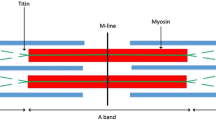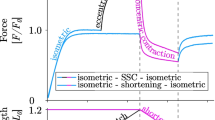Summary
A new computerized mechanical cell stimulator device for tissue cultured cells is described which maintains the cells in a horizontal position during mechanical stretching of up to 400% in substratum length. Mechanical stimulation of myogenic cells in this device initiates several aspects of in vivo skeletal muscle organogenesis not seen in normal static tissue culture environments. Embryonic skeletal muscle cells from avian m. pectoralis are grown in the device attached to the collagen-coated elastic substratum. Dynamic stretching of the substratum in one direction for 3 d at a rate (0.35 mm/h) that simulates in vivo bone elongation during development causes the myoblasts to fuse into parallel arrays of myotubes which are 2 to 4 times longer than myotubes grown under static culture conditions. This longitudinal myotube growth is accompanied by increased rates of cell proliferation and myoblast fusion. Prestretching the collagen-coated substratum before cell plating also results in increased cell proliferation, myotube orientation, and longitudinal myotube growth. The effects of substratum stretching on myogenesis in this model system thus occur by alterations in the cell’s extracellular matrix and not by acting directly on the cells.
Similar content being viewed by others
References
Abercrombie, M. Contact inhibition and malignancy. Nature 281:259–262; 1979.
Alder, A. B.; Crawford, G. N. C.; Edwards, R. G. The effect of limitation of movement on longitudinal muscle growth. Proc. R. Soc. (Lond., Ser. B) 150:554–562; 1959.
Bassett, C. A. Biophysical principles affecting bone structure. In: Bourne, H. G., ed. Biochemistry and physiology of bone, 2nd ed. New York: Academic Press; 1972:1–76.
Belloussou, L. V.; Dorfman, J. G.; Cherdantzev, V. G. Mechanical stresses and morphological patterns in amphibian embryos. J. Embryol. Exp. Morphol. 34:559–574; 1975.
Buckley, M. J.; Banes, A. J.; Levin, L. G., et al. Osteoblasts increase their rate of division and align in response to cyclic mechanical tension in vitro. Bone Miner. 4:225–237; 1988.
Campion, D. R. The muscle satellite cell: a review. Int. Rev. Cytol. 87:225–251; 1984.
Carey, E. J. Studies in the dynamics of histogenesis. IV. Tension of differential growth as a stimulus to myogenesis. Am. J. Anat. 29:93–115; 1921.
Chevallier, A.; Kieny, M.; Mauger, A., et al. Developmental fate of the somatic mesoderm in the chick embryo. In: Ede, A. D.; Hinchliffe, J. R.; Ball, M. eds. Vertebrate limb and somite morphogenesis. London: Cambridge University Press; 1977:421–432.
Chiquet, M.; Eppenberger, H. M.; Turner, D. C. Muscle morphogenesis: evidence for an organizing function of exogenous fibronectin. Dev. Biol. 88:220–235; 1981.
Chiquet, M.; Puri, E. C.; Turner, D. C. Fibronectin mediates attachment of chicken myoblasts to a gelatin-coated substratum. J. Biol. Chem. 254:5475–5482; 1979.
de la Haba, G.; Amundsen, R. The contribution of embryo extract to myogenesis of avian striated muscle in vitro. Proc. Natl. Acad. Sci. USA 69:1131–1135; 1972.
Ede, D. A.; Flint, O. P. Cell movement and adhesion in the developing chick wing bud: studies on cultured mesenchymal cells from normal and talpid mutant embryos. J. Cell Sci. 18:301–313; 1975.
Folkman, J.; Moscona, A. Role of cell shape in growth control. Nature 273:345–349; 1978.
Goldspink, G. Alterations in myofibril size and structure during growth, exercise, and changes in environmental temperature. In: Peachey, D. L.; Adrian, R. H.; Geiger, S. R., eds. Handbook of Physiology. Section 10. Skeletal Muscle. Bethesda, MD: American Physiological Society; 1983:539–554.
Goss, R. J. Regulation of organ and tissue growth. New York: Academic Press; 1972.
Hauschka, S.; Konigsberg, I. R. The influence of collagen on the development of muscle clones. Proc. Natl. Acad. Sci. USA 55:119–126; 1966.
Hironaka, T.; Ikari, Y.; Miyata, Y. Development and growth of extensor arpi radialis longus muscle in normal and dystrophic chickens. Exp. Neurol. 83:378–391; 1984.
Holmes, L. B.; Trelstad, R. L. Cell polarity in precartilage mouse limb mesenchyme cells. Dev. Biol. 78:511–520; 1980.
Kardami, E.; Spector, D.; Strohman, R. C. Myogenic growth factor present in skeletal muscle is purified by heparin-affinity chromatography. Proc. Natl. Acad. Sci. USA 82:8044–8047; 1985.
Kuhl, U.; Ocalon, M.; Timpl, R., et al. Role of laminin and fibronectin in selecting myogenic versus fibrogenic cells from skeletal muscle in vitro. Dev. Biol. 117:628–635; 1986.
Landmesser, L. T.; O’Donovan, M. J. Activation patterns of embryonic chick hind limb muscles recorded in ovo and in an isolated spinal cord preparation. J. Physiol. 347:189–204; 1984.
Luther, P. W.; Peng, H. B.; Lin, J. J. C. Changes in cell shape and actin distribution induced by constant electric fields. Nature 303:61–64; 1983.
MacKay, B.; Harrop, T. J. An experimental study of the longitudinal growth of skeletal muscle in the rat. Acta. Anat. 72:38–49; 1969.
Mayne, R.; Sanderson, R. D. The extracellular matrix of skeletal muscle. Collagen Relat. Res. 5:449–468; 1985.
Odell, G. M.; Oster, G.; Alberch, P., et al. The mechanical basis of morphogenesis I. Epithelial folding and invagination. Dev. Biol. 85:446–462; 1981.
Olwin, B. B.; Hall, Z. Developmental regulation of laminin accumulation in the extracellular matrix of a mouse muscle cell line. Dev. Biol. 112:359–367; 1985.
Pearson, M. L.; Epstein, H. F. Muscle Development: molecular and cellular control. New York: Cold Spring Harbor Laboratory; 1982.
Sheehan, D. C.; Hrapchak, B. B. Theory and practice of histochemistry. St. Louis: C. V. Mosby Co.; 1980:143.
Shellswell, G. B.; Bailey, A. J.; Duance, V. C., et al. Has collagen a role in muscle pattern formation in the chick wing? 1. An immunofluorescence study. J. Embryol. Exp. Morphol. 60:245–254; 1980.
Stewart, D. M. The role of tension in muscle growth. In: Goss, R. J., ed. Regulation of organ and tissue growth. New York: Academic Press; 1972:77–100.
Summers, P. J.; Ashmore, C. R.; Lees, Y. B., et al. Stretch-induced growth in chicken wing muscles: role of soluble growth-promoting factors. J. Cell. Physiol. 125:288–294; 1985.
Totsuka, T. A bone-inbalance hypothesis for the pathogenesis of murine muscular dystrophy. In: Ebashi S.; Ozawa, E., eds. Muscular dystrophy: biochemical aspects. Tokyo and Berlin: Japan Science Society Press and Springer-Verlag; 1983:29–38.
Turner, D. C.; Gibralter, D. Regulation of cell interactions during skeletal muscle development. Curr. Top. Cell. Regul. 26:115–126; 1985.
Turner, D. C.; Lawton, J.; Dollenmeier, P., et al. Guidance of myogenic cell migration by oriented deposits of fibronectin. Dev. Biol. 95:497–504; 1983.
Vandenburgh, H. H. Dynamic mechanical orientation of skeletal myofibers in vitro. Dev. Biol. 93:438–443; 1982.
Vandenburgh, H. H. Cell shape and growth regulation in skeletal muscle: exogenous versus endogenous factors. J. Cell. Physiol. 116:363–371; 1983.
Vandenburgh, H. H. Motion into mass: How does tension stimulate muscle growth?. Med. Sci. Sports Exercise 19:S142-S149; 1987.
Vandenburgh, H. H. A computerized mechanical cell stimulator for tissue culture: effects on skeletal muscle organogenesis. In Vitro 24:609–619; 1988.
Vandenburgh, H. H.; Kaufman, S. In vitro model for stretch-induced hypertrophy of skeletal muscle. Science 203:265–268; 1979.
Weiss, P. Functional adaptation and the role of ground substance in development. Am. Naturalist 118:389–407; 1933.
Williams, P. E.; Goldspink, G. The effect of immobilization on the longitudinal growth of striated muscle fibers. J. Anat. 116:45–55; 1973.
Yoshizato, K.; Obinata, T.; Huang, H., et al. In vitro orientation of fibroblasts and myoblasts on aligned collagen film. Dev. Growth Differ. 23:175–184; 1981.
Author information
Authors and Affiliations
Additional information
This work was supported by grant AR36266 from the National Institutes of Health, Bethesda, MD, and research grnat NAG2-414 from the National Aeronautics and Space Administration, Washington, DC. Parts of this work have appeard in abstract form, J. Cell. Biochem. 12C:360; 1988.
Rights and permissions
About this article
Cite this article
Vandenburgh, H.H., Karlisch, P. Longitudinal growth of skeletal myotubes in vitro in a new horizontal mechanical cell stimulator. In Vitro Cell Dev Biol 25, 607–616 (1989). https://doi.org/10.1007/BF02623630
Received:
Accepted:
Issue Date:
DOI: https://doi.org/10.1007/BF02623630




